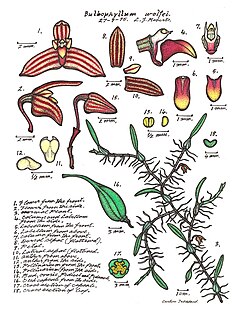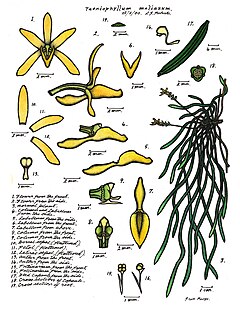Bulbophyllum boonjee commonly known as the maroon strand orchid, is a species of epiphytic orchid that is endemic to tropical North Queensland. It has crowded, flattened pseudobulbs, stiff, pale green leaves and up to four small, bell-shaped maroon flowers with darker stripes.
Bulbophyllum macphersonii, commonly known as eyelash orchids, is a species of epiphytic or lithophytic orchid that is endemic to Queensland. It has tiny, crowded, slightly flattened, dark green pseudobulbs, a single thick, fleshy leaf and a single dark red to purplish red flower with a narrow labellum. It grows on trees and rocks in sheltered places.

Bulbophyllum wolfei, commonly known as the fleshy snake orchid, is a species of epiphytic or lithophytic orchid with thin, creeping rhizomes, and flattened pseudobulbs each with a single thick, fleshy, dark green leaf and a single cream-coloured flower with dark red stripes. It mostly grows on rainforest trees in tropical North Queensland.
Chiloschista phyllorhiza, commonly known as the white starfish orchid, is a species of leafless epiphytic or lithophytic orchid that forms small clumps with many radiating, flattened green roots. A large number of short-lived, crystalline white, star-shaped flowers with a yellow labellum are arranged along thin, arching flowering stems. It occurs in northern parts of Australia where it grows in rainforest, swamps and near streams.
Drymoanthus minutus, commonly known as the green midget orchid, is a species of epiphytic or lithophytic orchid that forms small clumps with many thick roots emerging from a thin, erect stem. Between two and five dark green, leathery leaves are arranged along the stem and up to seven minute green to yellowish, star-shaped flowers are arranged on a stiff flowering stem. The sepals and petals are similar to each other and there is a fleshy white, unlobed labellum. This orchid occurs in northern Queensland where it grows in rainforest, usually at higher altitudes.

Luisia tristis, commonly known as the velvet orchid, is a species of epiphytic or lithophytic orchid with wiry stems often forming tangled clumps, cylindrical leaves and flowering stems with up to three green flowers with a dark red to dark maroon labellum. This orchid occurs in tropical Asia, New Guinea, Australia and some islands of the Western Pacific Ocean.
Taeniophyllum clementsii, commonly known as the fleshy threadfoot, is a species of leafless epiphytic orchid which only grows as single plants. It has short stems and flattened green roots pressed against the tree on which it is growing. Between five and fifty small, pale green, tube-shaped flowers are arranged on a zig-zagged flowering stem. The flowers open one at a time, with the flowering stem increasing in length as each flower opens. This orchid only grows in a small area of tropical North Queensland.

Robiquetia gracilistipes, commonly known as the large pouched orchid, is an epiphytic or lithophytic orchid from the family Orchidaceae that forms large, hanging, straggly clumps. It has long, thick, roots, a single stem, many thick, leathery leaves and up to forty cream-coloured, pale green or brownish flowers with red spots and a three-lobed labellum. It grows on trees and rocks in rainforest, usually in bright light. It is found in Malesia including New Guinea, the Solomon Islands and tropical North Queensland, Australia.
Saccolabiopsis armitii, commonly known as the spotted pitcher orchid, is an epiphytic orchid from the family Orchidaceae. It has a short stem, coarse, wiry roots, between three and six crowded, curved leaves and up to fifty yellowish green flowers with red markings and a white labellum. It usually grows in coastal scrub to rainforest in New Guinea and tropical North Queensland, Australia.
Saccolabiopsis rectifolia, commonly known as the tiny pitcher orchid, is an epiphytic orchid from the family Orchidaceae. It has a short stem, thin roots, between three and six crowded leaves and up to fifteen cup-shaped green flowers with a white, purple spotted labellum. It grows on the thinnest outer branches of rainforest trees in tropical North Queensland, Australia.
Taeniophyllum muelleri, commonly known as the chain ribbonroot, is a species of leafless epiphytic or lithophytic orchid that usually forms tangled colonies. It has short stems and cylindrical green roots pressed against the substrate on which it is growing. Between five and twelve yellowish green, tube-shaped flowers open one at a time. This orchid occurs in eastern Australia and New Caledonia.

Taeniophyllum hasseltii, commonly known as the Christmas Island ribbonroot, is a species of leafless epiphytic or lithophytic orchid that forms small clumps. It has short stems and flattened silvery grey roots pressed against the substrate on which it is growing. The flowers are tube-shaped, pale yellow and open one at a time. This orchid is only known from Christmas Island, an Australian territory and the Indonesia island of Java.

Taeniophyllum lobatum, commonly known as the yellow ribbonroot, is a species of leafless epiphytic or lithophytic orchid that forms small clumps. It has short stems, flattened pale to greyish green roots pressed against the substrate on which it is growing and usually two pale to bright yellow flowers. It only occurs in tropical North Queensland.

Taeniophyllum malianum, commonly known as the tangled ribbonroot, is a species of leafless epiphytic or lithophytic orchid that forms tangled clumps. It has flattened green roots with irregular white spots and pressed against the substrate on which it is growing. There are up to fifteen fragrant yellow, short-lived flowers with up to three open at the same time. It only occurs in tropical North Queensland and in New Guinea.
Taeniophyllum norfolkianum, commonly known as the Norfolk Island ribbonroot, is a species of small, leafless epiphytic orchid. It has short stems, cylindrical green roots pressed against the substrate on which it is growing and between two and five small, tube-shaped, yellowish green flowers opening one at a time. It occurs on Norfolk Island but has also been reported from the North Island of New Zealand.

Thrixspermum congestum, commonly known as the cupped hairseed, is an epiphytic or lithophytic orchid that forms small clumps with many thin roots, up to fifteen leathery leaves and many star-shaped white or cream-coloured flowers. This orchid occurs from Papuasia to northern Australia.

Trachoma stellatum, commonly known as the starry spectral orchid, is an epiphytic or lithophytic clump-forming orchid with many thick roots. It has between three and eight thick, leathery leaves and many short-lived, cream-coloured flowers with purple markings and a yellow-tipped labellum. This orchid occurs in tropical North Queensland.
Trachoma papuanum, commonly known as the yellow spectral orchid, is an epiphytic or lithophytic clump-forming orchid with a between three and six thick, fleshy leaves and many dull yellow flowers with a white labellum opening in groups of up to four. This orchid occurs in New Guinea, Queensland and some islands in the South Pacific.

Bryobium queenslandicum, commonly known as the dingy urchin orchid, is an epiphytic or lithophytic clump-forming orchid that has cylindrical, fleshy green pseudobulbs, each with two leaves and between three and twelve small, self-pollinating, cream-coloured or pinkish flowers. This orchid only occurs in tropical North Queensland.
Bryobium retusum, commonly known as the Christmas Island urchin orchid, is an epiphytic clump-forming orchid that has oval, fleshy green pseudobulbs, each with two leaves and between seven and twelve short-lived, self-pollinating, pale green, hairy flowers. This orchid is found between Java and New Caledonia.








